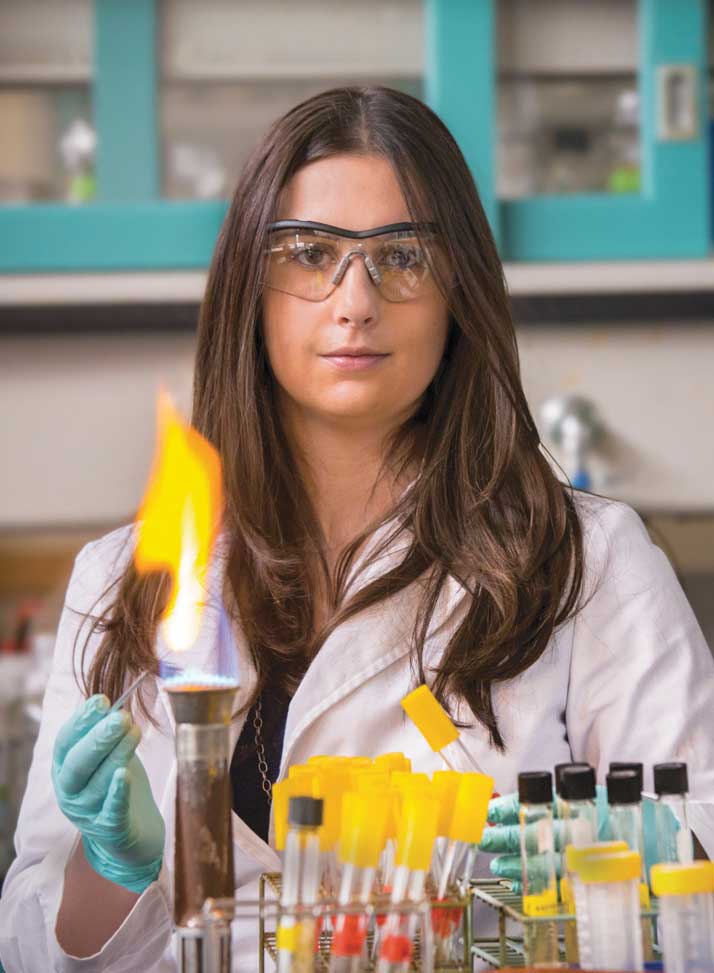Just months away from attaining her doctorate, Stephanie Kunkel (M.S. BIOL ’11, Ph.D. ’14) fills test tubes at her workbench in the Life Sciences Building, her long brown hair under a navy Arizona ball cap she wears in support of the Wildcats basketball team. While Kunkel was introduced to the laboratory as a University of Arizona undergraduate, IIT is where she established herself as a researcher. Her academic path has led to increasingly satisfying research challenges, prominent awards, and the realization that her calling lies in teaching.
“It seems that my plan was always to teach,” says Kunkel, thinking back on her five years at the university. “I’ve been a teaching assistant at IIT each semester that I’ve been here. I enjoy instilling the love of doing research into the students and seeing the looks on their faces when they get what I’m teaching.”

Photo by: Michael Goss
Raised in an environmentally conscious family, Kunkel began her laboratory experience investigating annual plants of the Southwestern desert region where she lived. She also interned for the Muscular Dystrophy Association; this led to her acquaintance with IIT Associate Professor Nick Menhart and his Duchenne muscular dystrophy research. Kunkel decided to pursue her graduate education at IIT and continued her environmental studies under the mentorship of Ben Stark, professor of biology, and Krishna Pagilla, professor of environmental engineering.
The focus of Kunkel’s graduate research was on bacterial hemoglobin and its potential in biofuel production and wastewater treatment. In her master’s program she explored how the Vitreoscilla hemoglobin protein (VHb)—discovered by Dale A. Webster, IIT Distinguished Professor of Biology—can enhance ethanol production and then applied that knowledge to wastewater for her doctoral program. Certain bacteria can make hemoglobin under conditions of low oxygen or stress and like the oxygen-transporting hemoglobin of red blood cells can carry dissolved gases.
“Up to 70 percent of the energy needed to run a wastewater treatment plant goes into aerating the water. I wondered how we could make the process greener and reduce the energy cost,” says Kunkel.
Over a 14-month period, she conducted two experiments. In one, she ran wastewater samples at both high-oxygen and low-oxygen levels to observe if hemoglobin production could be directed as the bacteria adapted to lower rates of aeration. In the other, she inserted VHb into the bacterium Nitrosomonas europaea, which is commonly found in wastewater sludge, in the hope that it would take up more oxygen than the naturally occurring bacterium without the special hemoglobin.
“If we could express or enhance the level of hemoglobin in the bacteria, they’ll be able to grab the oxygen more efficiently, which means that the treatment plant could be operated at a lower oxygen level. Lower oxygen levels mean less aeration of the plant, which in turn leads to potentially significant energy savings,” explains Kunkel, who earned a 2013 GEN 10 Award from Genetic Engineering & Biotechnology News for excellence in scientific research and a 2013 University Research Honor Award from the American Academy of Environmental Engineers and Scientists.
At the end of her 14-month test period, Kunkel observed that the bacteria became more oxygen-efficient in their adaptation to the low-oxygen environment and that the VHb-enhanced sludge bacteria did have a slightly higher oxygen uptake rate than did those without it.
This month, Kunkel is taking her environmental interests in still another direction as the recipient of a two-year $120,000 postdoctoral fellowship from the Alfred P. Sloan Foundation. She and Assistant Professor Brent Stephens, director of the IIT Built Environment Research Group, will investigate the mechanisms by which aerosolized bacteria and viruses are spread among humans in the indoor environment.
More Online
Habitat for Humanity: www.habitat.org
Architecture for Humanity Chicago: chicago.architectureforhumanity.org